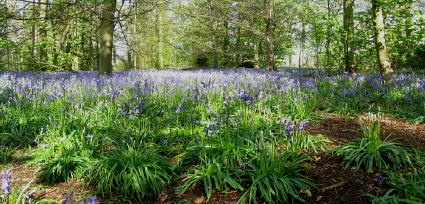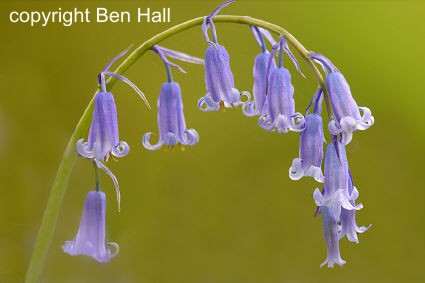BLUEBELL (HYACINTHOIDES NON-SCRIPTA)
LOCAL BIODIVERSITY ACTION PLAN
Links to associated HAPs
Ancient Semi-natural Broadleaved Woodland BAP
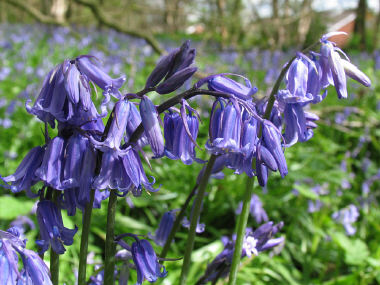 Current
Status
Current
Status
The U.K. has 30% of the global population of bluebells. Therefore it is essential that the Cheshire region maintain its proportion of this internationally important species. The plant is common throughout Britain, occurring widely, except in Orkney and Shetland. Bluebells are also found scattered throughout western Europe, mainly in France, the Netherlands and Belgium and they have become naturalised in central Europe. This species of bluebell (Hyacinthoides non-scripta) should not be confused with the non-native Spanish Bluebell (Hyacinthiodes hispanica). The latter is frequently planted in gardens but the two species hybridise with each other freely.
The bluebell occurs typically in deciduous woodland, especially coppice, where it may dominate the ground flora. It can be common in other shady places such as hedgerow banks and under bracken as well as more open habitats, such as costal grassland in the west of Britain. Humidity and continuity of habitat are key requirements for this species.
Native bluebells are protected under Section 13 (2) of the Wildlife and Countryside Act (1981).
Threats
- Loss or poor management of broadleaved woodland and hedgerow habitat or replanting of broadleaved woodland with conifers.
- Physical damage to leaves and bulbs by trampling or heavy grazing by livestock and deer.
- Exploitation for commercial purposes.
- Hybridisation with Spanish bluebells.
- Tipping of garden waste in woodlands and hedgerows.
- Lack of knowledge about conditions bluebells need to regenerate.
How are we helping to conserve Bluebells in the Cheshire region?
-
'The Bluebell Recovery Project' undertaken by Landlife and The Mersey Forest Team continues and is now producing a sustainable source of native bluebell bulbs to help halt the illegal trade in bulbs looted from the wild.
-
The Cheshire Bluebell Action Project began in 2002, co-ordinated by a project officer.
-
Identification of woodlands which have significant populations of bluebells.
-
Conservation and woodland management activities of many individuals and organisations in the region.
-
Objectives, Targets and Actions
OBJECTIVES |
LOCAL TARGETS |
| To identify all bluebell sites in the Cheshire region. |
Carry out 8 surveys per year for the period 2004 - 2010. |
| Add all data to Recorder 2002 to show annual increase of our site knowledge. To be collated by rECOrd. |
| To protect all bluebell woodlands and other bluebell habitats in the Cheshire region. |
Maintain current extent of x ha. (Population in Cheshire region is not known. The 2004 Bluebell Action Project final report has allowed an updated species map to be produced, based on 1300 species observations) |
| Generate publicity highlighting the threats to the species and how people can help |
| Emphasise the importance of people staying on the paths when walking in woodlands |
| Raise the profile and promote community involvement of the bluebell within Cheshire. |
Create a sustainable source of bulbs, through a programme of initial surveying, seed collection, seed distribution, bulb cultivation, and reintroducing bluebells back into suitable woodland sites |
| Continue 'The Bluebell Recovery Project' for the period 2004 - 2007 |
| To link new bluebell seeding / bulb planting with ancient woodland schemes in the Cheshire region. |
Introduce native bluebell bluebells from the "Bluebell Recovery Project" to Jigsaw grant schemes. |
| To promote education and awareness in order to encourage responsible attitudes towards conserving ancient woodlands. |
Produce and distribute leaflet to raise awareness of conservation issues for ancient woodlands during y period. |
| Raise awareness amongst landowners of the damage that deer and livestock can do to woodlands and the need for fencing |
| ACTIONS REQUIRED |
- A new edition of the Bluebell Express newsletter
- Continued growing of bulbs at Barrowmore
- A specific bluebell monitoring scheme and planting strategy, as part of the Halton BAP
- Other blubell schemes planned for 2007 include:
- Furey Woodland, as part of a bulb planting project
- Helsby quarry possibly
- Handforth Wood
- Dukes Drive, Chester
|
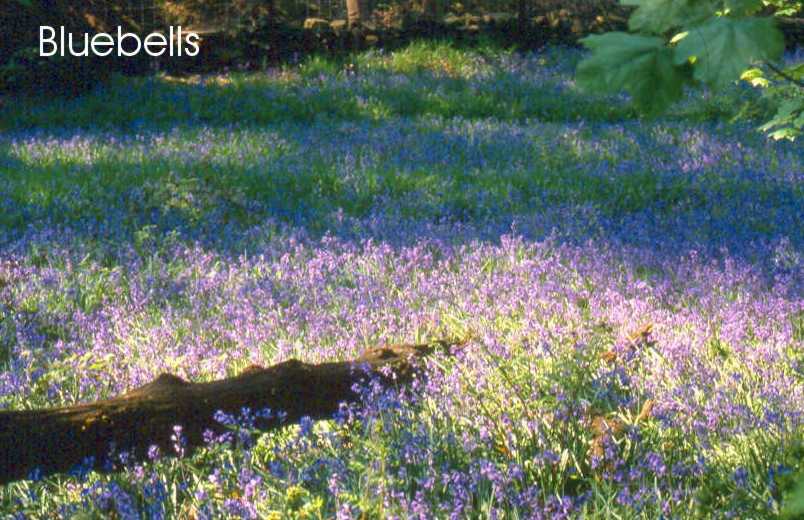 |
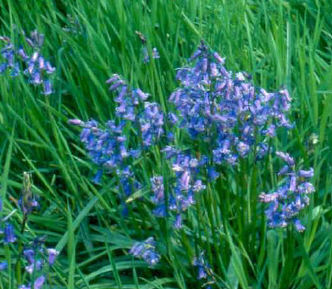 |
Progress so far
| 2006 Action Completed |
- 4 detailed bluebell surveys and 5 site visits during the Spring, mainly in the Macclesfield / Congleton area.
- Launch of the Barrowmore bluebell project. This includes growing on native English bluebell seeds and bulbs for woodland planting and community schemes in a few years time.
- A bluebell Haiku competition for schools in the Bollin Valley
- 21,500 bluebell bulbs were planted on Local Nature Reserves and other selected sites in Halton. The project was overseen by Sam Langdon from rECOrd, with most of the planting by the BTCV
|
2005 Action Completed |
- Completion of the final report of the Cheshire Bluebell Action Project, containing additional survey work carried out in Spring 2005. This report completes the main part of the WREN funded project from 2001-2003 and extended to cover 2003 – 2005!
- Bluebell surveys carried out at:
Adlington Wood, Macclesfield
Chester Zoo
Tytherington Wood, Macclesfield
The Dingle, Chester and Blacon Nature Park, Chester
Long Acre Wood, Dutton
Marbury Country Park
Barrowmore Estate, near Barrow
H igher Disley woodland
- Community seed gathering events at:
Owley Wood
Marbury Country Park
Poynton Coppice
Various sites in the Bollin Valley Partnership
Norley Nursery
- Successful application to WREN to start a Bluebell nursery at Barrowmore.
- Financial contribution to native bulb growing at Landlife as part of the Bluebell Recovery project
- Advice given to landowners on bluebells, their status and opportunities for seed and bulb distribution
|
2004 Action Completed |
- In 2004 the final report of the Cheshire Bluebell Action Project, covering the period 2001-3, was produced. This report completed the main part of the WREN funded project.
- 8 Bluebell surveys were carried out in 2004 at:
Woodland near Chester Zoo (rECOrd)
Shotwick Hall Farm (HH)
Caldy Valley ( PO)
Woodland at Buglawton (rECOrd)
Peckforton Hill ( PO)
Owens Wood, near Church Minshull
Greenbank Wood (VH)
Eastwood nature reserve(HH) (NB These survey’s were an extension of the WREN funded bluebell action project)
- 5 community seed gathering events were held in 2004 at:
Murdishaw wood, Runcorn
Big Wood, Runcorn
Marbury Country Park
Owley wood
Old Covert, Crewe at: (NB These survey’s were an extension of the WREN funded bluebell action project)
- 5 bulb planting events were held in 2004 at:
Brines Brow / The Yeld
Caldy Valley
Spud Wood
Old Covert, Crewe
- A financial contribution to native bulb growing at Landlife as part of the Bluebell Recovery project was received in 2004.
- Advice was given to landowners on bluebells, their status and opportunities for seed and bulb distribution throughout 2004.
|
1997 - 2004 Action Completed |
- The first meeting of the LBAP Action Group was held on 24th May, 1999 at Spike Island, Widnes.
- The first 5 years of the Bluebell Recovery Project has seen native bulbs being put back into the wild, for instance at Wigg Island Community Park, Runcorn and Old Chester Road, Daresbury.
- During the first 2 years of the Cheshire Bluebell Action project. 19 woodlands have been surveyed, a bluebell postcard has been produced to raise awareness and encourage people to send in records. There has also been 18 community seed gathering events and at least 6 bulb planting events. The survey work has revealed a greater amount of hybridisation in rural bluebell woodlands than previously known. There has been continue discussion within the BAP Group on the "english / spanish bluebell" debate, and whether or not trying to keep a stock of native bulbs separate from hybrids and spanish is "a lost battle". There are a number of arguments for pursuing the cultivation of native stock, especially when so little is currently known at the genetic level. The debate will continue in the group for some time!
- Species recording card for bluebells produced by Cheshire County Council and Vale Royal Borough Council.
- Participation in the national bluebell survey organised by Plantlife. Over 80 separate sites throughout Cheshire were surveyed using the nationwide survey sheets and submitted to the project, with all information also going to rECOrd for future use. For further information, see www.plantlife.org.uk
|
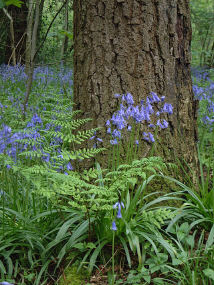 |
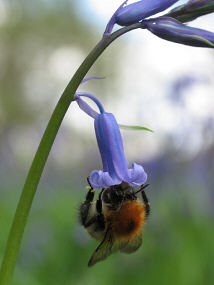 |
How to find out more about Bluebells
Vale Royal Borough Council Bluebell Species Recording card
Plantlife - www.plantlife.org.uk
Cheshire Bluebell Action Project Report
How can you get involved?
The Bluebell LBAP Project has received funding from WREN to carry out survey work, seed collection and bulb planting in a number of woodlands in Cheshire. 11 woods have now been surveyed as part of the project and 6 found to be suitable for seed collection and community planting schemes. Several of the sites surveyed were found to be not suitable for seed collection at all due to the high incidence of hybrid or alien bluebells present.
The Bluebell LBAP Action Group hope to organise 12 seed collecting and 12 bulb planting events involving the community each year, 6 in the spring and 6 in the summer, using the funding provided by WREN. There have also been 2 community planting events at Owley Wood, Northwich and Old Covert Wood, Wistaston, using chipped, native bulbs supplied by Landlife, the national wildflower centre.
For more details on getting involved in these events or in any of the other work being done for bluebells in Cheshire, please contact the Bluebell LBAP Action Group Chair (see below).
Contact details
References & Glossary
HMSO (1995): Biodiversity: The UK Steering Group Report, Volume 1: Meeting the Rio Challenge, London.
HMSO (1995): Biodiversity: The UK Steering Group Report, Volume 2:Action Plans, London.
Plantlife (2004): Bluebells for Britain – a report on the 2003 Bluebells for Britain survey.
Rodwell, J. and Patterson, G (1994): Bulletin 112: Creating New Native Woodlands, HMSO, London.


 Current
Status
Current
Status 